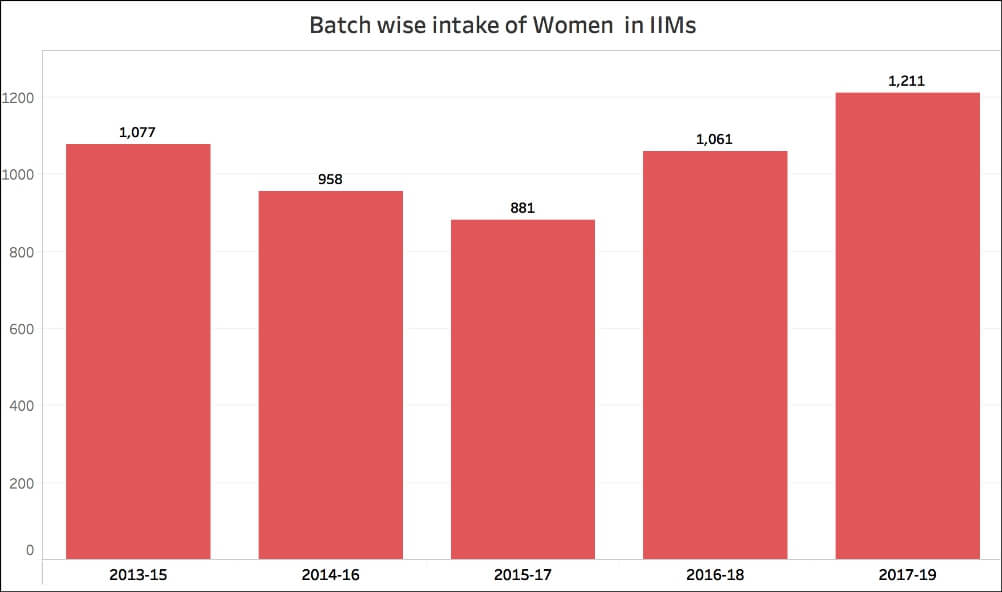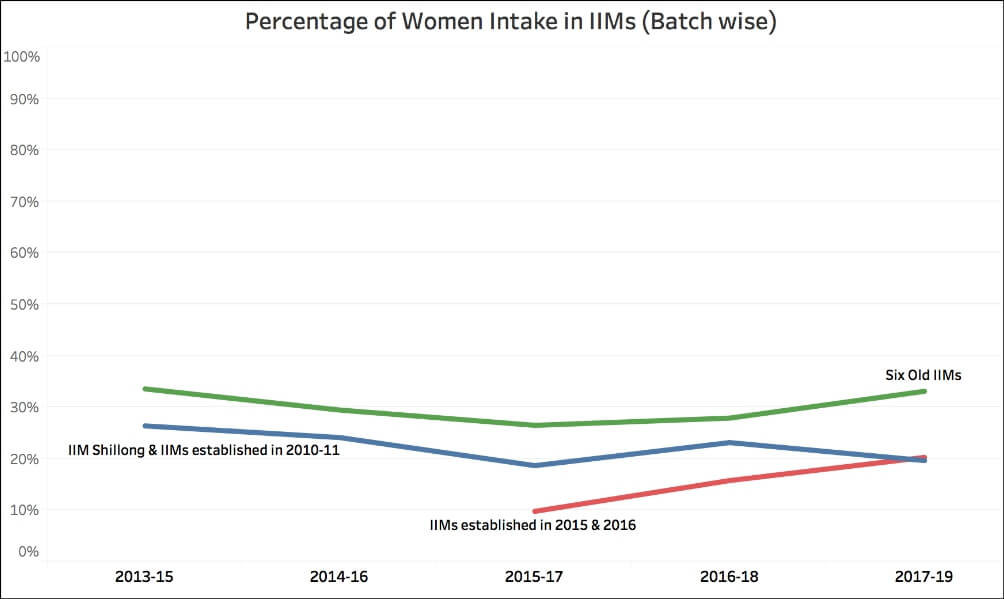[orc]IIMs have been trying to improve gender diversity in campuses for the last 10 years through means like specific weightage for gender diversity. While some IIMs consistently had more than 30% women, others have fallen back.
Historically, Indian Institutes of Management (IIMs) have been male bastions with majority of the incoming students having a degree in engineering. Over the past few years, several public policy and research studies have been pushing for a more gender diverse pool of students at India’s top management institutions. The coveted IIMs have made a conscious effort in the last 10 years to improve the gender diversity in campuses.
Data shared by the government and individual IIMs shows a mixed trend in terms of gender diversity. From 31.7% women in the 2013-15 batch, it has come down to 27.5% women in the 2017-19 batch. It is observed that some IIMs have been performing better than the others in improving diversity. These numbers relate to the flagship Post Graduate Program (PGP) of the IIMs.
Number of Women in IIMs crosses 1200 in 2017
For both the 2013-15 & 2014-16 batches, only 13 IIMs were operational. In 2015, six (6) more IIMs started operations taking the total number to 19. IIM Jammu started operations in 2016 taking the total number of IIMs to 20. The total intake of the IIMs has also increased by about 30% between 2013 and 2017. The total intake increased from 3394 for the 2013-15 batch to 4399 for the 2017-19 batch.
The intake of women crossed 1000 for the 2013-15 batch only to progressively decrease the next two years. Ironically, the lowest intake of women in the last five years has been for the 2015-17 when the number of IIMs increased from 13 to 19 for the first time. Since 2015, the intake of women has seen an increasing trend again and reached an all-time high of 1211 for the 2017-19 batch.
In terms of percentage, the women in IIMs reached a peak of 31.7% in the 2013-15 batch only to fall to 23.3% in the 2015-17, the lowest in these 5 years. Since then, it has again increased to 27.5% in the 2017-19 batch. On the whole, in 5 years, there has been a 4% drop in women intake.
What about the old IIMs?
The gender diversity trend in the oldest IIMs (Ahmedabad, Bangalore & Calcutta) is mixed. In IIM Ahmedabad where there is no specific weightage for gender diversity, the percentage of women reached a high of 35% in 2014-16 batch only to go down by almost half in the subsequent year. In the last two years, there has been an increase again with the 2017-19 batch comprising 33.4% women.
In the case of IIM Bangalore which has a specific gender diversity weightage, the percentage of women has more or less been around 25% in every batch.
In the case of IIM Calcutta that also has a weightage for gender diversity, women intake reached a low of 16.4% in 2016-18, only to increase to an all-time high of 30.9% in 2017-19.
IIM Lucknow has maintained the women intake percentage of more than 30% except for the 2015-17 batch.
IIM Indore also maintained the 30% mark except for the 2014-16 batch. The women intake in the 2017-19 batch of IIM Indore crossed 40%.
The case of IIM Kozhikode is strange because the women constituted more than half the batch in 2013-15 whereas the percentage of women in 2017-19 batch was only 28.9%.
The combined women intake in the six old IIMs was around 30% except in the 2015-17 & 2016-18 batches.
Old IIMs doing better, new IIMs need to catch up
If all the IIMs are grouped into the following categories, the old ones seem to be doing better on the gender diversity front.
- Established IIMs (Ahmedabad, Bangalore, Calcutta, Lucknow, Indore & Kozhikode)
- IIM Shillong & IIMs established in 2010-11 ( Rohtak, Raipur, Ranchi, Tiruchirapalli, Udaipur & Kashipur)
- IIMs established in 2015-16 (Amritsar, Bodhgaya, Nagpur, Sirmaur, Visakapatnam, Sambalpur & Jammu)

In the case of IIM Shillong & other IIMs established in 2010-11, the percentage intake of women was more than 25% in 2013-15, but it has come down continuously after that to fall below 20% in 2017-19.
In the case of the other seven IIMs established in 2015-16, the intake of women increased from 9.8% in 2015-17 batch to 20.3% in 2017-19 batch.
But there are exceptions within IIMs. For instance, intake of women in IIM Ranchi has been more than 50% in three of these five years. On the other hand, intake of women in IIM Rohtak went down from 48.3% in 2013-15 batch to less than 10% in 2017-19 batch. It has to be noted that both these IIMs have a specific gender diversity weightage as a part of their selection criteria.
Gender Mainstreaming in IIMs
Majority of the IIMs include weightage for gender diversity in one of the stages for selection while others like IIM Ahmedabad, Shillong & Nagpur do not have any weightage for gender diversity. But the percentage of women intake in both the sets of IIMs is not very different and doesn’t seem to be correlate positively with the weightage.
Even the location of the IIM does not seem to be a major factor driving women intake in IIMs. Also, the difference in percentage of women candidates per every batch in the same institutions as well as other institutions in the same year needs to be studied to understand if the number of women candidates appearing for Common Admission Test (CAT) has drastically varied or the process of intake at individual institutions was the factor in having fluctuating gender diversity percentages.
The process of mainstreaming gender diversity needs to be streamlined in a way that all the IIMs follow a consistent weightage across the locations at least on the gender front. This is critical because all the candidates getting admitted are entering these institutions through a common examination in CAT immaterial of the location of final admission. Even though every IIM should freely choose an appropriate approach that reflects the values and culture of the respective campus philosophy like they are doing now, there is a need for a process which will hold them accountable to the commitment of a diverse pool. The mere inclusion of the gender diversity clause cannot make considerable and consistent progress to change to the pool of candidates without an aggressive implementation plan that keeps its engagement to inclusion and opportunity. Preferably a time bound plan, that is measurable and paves way for other education institutions in India to follow path.
Gender mainstreaming benefits in these institutions will not just be limited to access to more women candidates but it will indirectly also address the other social, cultural and educational background diversity deficit that IIM’s are parallely working to mitigate.
Data Analysis by Rakesh Dubbudu



1 Comment
Great article on gender diversity at IIMs . Kindly elaborate the point in last paragraph which says that ‘gender mainstreaming’ will indirectly help to mitigate social, cultural and educational deficit at IIMs.
Really need an insight on that point.
– Jain.parivesh01@gmail.com